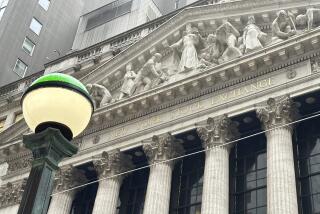Personal Finance: Keep the right bonds in your portfolio
Investors, made nervous by two years of roller-coaster performance in the stock market, have been pouring money into bond funds over the last year, seeking a haven for their assets.
But if interest rates start to rise next year — as most expect they will — these mutual funds that hold bonds may not look quite as profitable, experts say.
“As rates go up, bond prices come down,” says Steve Huber, head of portfolio strategies for fixed income at T. Rowe Price, a big mutual fund company in Baltimore. “The longer the maturities on your bonds, the bigger the risk you’re taking.”
If interest rates were to rise by 1 percentage point, the price of a 30-year U.S. Treasury bond would decline by 14.13%, according to a T. Rowe Price analysis. The price decline on a 10-year bond would be about half that, the company says.
Price declines on shorter-term Treasury bonds would be more modest — roughly 2% for a note with a two-year maturity and 4.5% for one with five years to go before the principal would be repaid. Naturally, if rates rise more, bond prices drop even more.
Yet investors need bonds as part of their portfolio, even in an environment of rising interest rates, experts concur. The question is, how do you buy bonds that won’t get trashed as interest rates rise? Here are some types of bonds to consider.
Look for a step-up. A number of issuers sell bonds that offer a fixed price for a set stretch of time, stepping up to better rates later, said Marilyn Cohen, author of “Bonds Now!” and chief of investment strategy at Envision Capital Management in Beverly Hills.
For instance, a new Fannie Mae “step-up” bond offers a 2% yield until November of 2011 but promises to pay 5% after that. The rate would rise to 6% in 2015 and to 7% in 2020. The catch? If market interest rates rise faster than the “step-up” on this bond, you’re stuck with the lower rate and no way to sell without taking a hit on the bond’s principal value.
Do you get the benefit of an above-market rate if market interest rates rise more slowly than the “step-up” schedule on the bond? Probably not, Cohen said. If interest rates are lower than the promised rate on the bond, the issuer has the right to “call” — or pay back — investors at any time, she said.
Check out floating rates. Corporate borrowers also issue some floating-rate debt that pays a variable interest rate based on an index, such as the London Interbank Offered Rate, or LIBOR, said Ann Benjamin, managing director and chief investment officer at Neuberger Berman, a New York-based investment firm.
Individual investors can get into this market by buying mutual funds that invest in floating-rate corporate debt. That gives you a “natural hedge” against rising interest rates, she said.
Consider junk. Interest rates are primed to rise now because the economy appears to be recovering, Benjamin added. That makes highly leveraged companies that issue high-yielding debt — often termed junk bonds — appear more financially stable. As a result the debt that these companies issue can rise in value even as interest rates rise because buying this debt becomes comparatively less risky.
“The high-yield market does well, even in a rising rate environment, because improving economic conditions tend to help companies’ credit quality,” she said. “You still have room for rates to rise before you have any impact on high-yield bond prices.”
Look at quality corporate bonds. Good-quality companies have also solidified their finances over the last year, cutting costs and hoarding cash, Cohen said. These companies now have balance sheets that should sustain their bond payments for a long time. That makes quality corporate bonds look attractive too.
A-rated corporate bonds don’t pay as much as junk bonds, but they still pay considerably more than Treasuries, with very little additional risk.
Tour the international markets. Buying the bonds of foreign governments may make some investors feel queasy, thanks to the Greek debt crisis that’s reverberated through the financial markets. But T. Rowe Price strategists think that the debt of some less-leveraged countries, such as Germany, France and Canada, is a good buy.
The caveat: When you buy bonds issued by foreign governments you also have to cope with currency risk because you must convert your U.S. dollars into foreign currencies when you buy and convert back into U.S. dollars when you sell and repatriate your money. Currency swings can have as big an effect on your investment as the yield on the bond.
Also be sure to diversify your bond portfolio just as you do with stocks. Investors sometimes forget to buy different types of bonds because bonds are typically less volatile than stocks. But that changes when interest rates are on the rise. You would be smart to hedge your bets by buying many different types of bonds.
More to Read
Inside the business of entertainment
The Wide Shot brings you news, analysis and insights on everything from streaming wars to production — and what it all means for the future.
You may occasionally receive promotional content from the Los Angeles Times.










